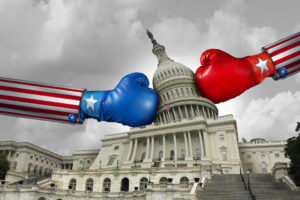Editor’s note: Hours after this was published, the governor, lieutenant governor and speaker wrote a memo to state agencies asking them to submit plans to cut 5% from their current budgets.
Despite an early heads-up from Texas Comptroller Glenn Hegar, who raised concerns in late March and early April that the current state budget will be billions of dollars out of balance, state agencies haven’t received any official requests to slow their spending.
Hegar’s warning that he would lower the official forecast of state revenue was ominous, unambiguous and a little blurry: “It’s probably going to be a revised downward adjustment of several billion dollars,” he said then. He has promised to put out exact numbers in mid-July, after the economic hits to retail sales, corporate franchise, and oil and gas tax revenues have come into focus.
In plain language, he told state leaders that Texas was in for a pay cut, and he did it just seven months into the state’s 24-month budget. If you expected to hear the squeal of brakes on spending, you were disappointed.
One exception was a missive weeks ago from House Speaker Dennis Bonnen. In early April, Bonnen sent a note to Gov. Greg Abbott and Lt. Gov. Dan Patrick, saying he wanted to talk about directing state agencies “to immediately identify and execute 5% budgetary savings.” In his memo, he said agencies would be better off making their cuts early, writing that “a small 5% course correction now, with nearly 17 months for implementation … is a far more achievable goal than having to attempt a much larger cut with a much shorter window for execution.”
Abbott, who heads the executive branch of government, where the vast majority of the money gets spent, hasn’t said a word. Hegar has informally talked to some state executives about what his agency has been doing to pare back, but there isn’t a statewide order.
Preparing for budget cuts has become routine — telling agencies not to press their luck as they prepare to seek lawmaker approval for their next budgets.
Four years ago, the state’s top three leaders asked state agencies to cut their budget requests by 4% — not a budget cut, exactly, but a pre-budget exercise to get the agencies accustomed to the idea that belt-tightening was ahead. That was in response to a slowdown in the economy, but without an oil bust or a pandemic adding to the drama.
Eight years ago, Speaker Joe Straus and Lt. Gov. David Dewhurst told state agencies to get ready for 10% budget cuts — and that was after lawmakers passed a tight 2011 budget that made massive cuts to public education, among other programs.
Lawmakers entered their 2011 session staring at a budget shortfall variously estimated from $15 billion to $27 billion. After the national economy tanked in 2008, federal stimulus money kept Texas state government out of immediate fiscal trouble. But that money was gone two years later, and the cuts were deep.
State leaders had spotted the trouble early that time. In January 2010, Gov. Rick Perry, along with Dewhurst and Straus, ordered agencies to cut 5% from their current budgets “due to the uncertainty of the state’s short-term economic future, as well as potentially substantial long-term costs associated with the passage of federal legislation currently being debated in Washington, D.C.”
Even with those cuts in place relatively early, the state still faced that monster shortfall in 2011. (And one that turned out to be far smaller than then-Comptroller Susan Combs had projected; lawmakers of both parties grumbled for years that they had made unpopular education cuts they didn’t have to make.)
And although it was a different set of leaders, the three folks in charge today were on the scene then: Abbott was attorney general, Patrick was a state senator and Bonnen was a member of the House. It’s not like this is their first rodeo.
Since Hegar first started telling lawmakers about the trouble ahead — adding the word “recession” to the conversation a few weeks later, when that seemed like a semi-risky thing to say — the economic picture has cleared, in the gloomiest way possible.
Retail sales fell 16.4% in April nationally, a sign of trouble for Texas, where sales taxes are the biggest single source of state government revenue. Texas businesses will file sales tax reports for April this week, giving the state its first full-month look at what the pandemic has done to the retail economy here. Hegar told a group of highway contractors this month that drops in oil and gas and motor fuels taxes will cut $600 million from the state highway fund’s revenue. He and other state leaders are hoping federal money will be available, as it has been for local governments so far.
The fiscal picture isn’t pretty, but it’s becoming clearer every day. State spending is not unaffected, even without instructions from top management; one big example is that the state’s $1.8 billion unemployment insurance fund is nearly depleted, thanks to the large number of Texans pushed out of work this year tapping those benefits.
Hard times are here for the state budget in Texas — with or without high-level instructions telling agencies to spend less money.
Originally posted by Ross Ramsey for The Texas Tribune.





